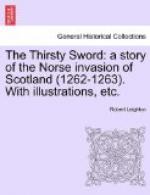The castle of Rothesay was so situated that it commanded a long view of the waters through which the enemy’s ships must approach from the north of the island. The fortress, which was constructed of stone, had been built in the year 1098 by Magnus Barelegs, king of Norway, who lived in Bute for three years. It was a circular building, 150 feet in diameter. The walls were nine feet thick and forty feet high, flanked by four round towers. As a fortification it was ill designed, even upon ancient principles. Though stronger than any other in all the Western Isles, it had neither moat nor drawbridge. Even the gate, though it was of strong oak, lined with iron bars, was ill protected. It was neither flanked nor machicolated, and it might have been mined or assaulted at any point. The enemy could approach under the walls without fear of being annoyed by showers of boiling lead or tar, and, if they kept close in, neither could arrows reach them with any certain aim.
But on the castle’s heights there had been collected many tons weight of missile weapons, with machines for throwing them. One of these machines was a Norse skotvagn or shooting truck. It was made like a wagon, mounted on a pair of wheels. At its back end was a long shaft with an open box at its extremity. This box had to be loaded with heavy stones. Fixed to the axle of the wagon were two chains, one at either side, so strong as to be able to suddenly check and hold the carriage when it was running full tilt down a planked incline. As soon as the chains arrested its race, it would shoot out its load on those below. It was always best to load it with stones of different sizes.
Kenric was engaged in giving a last attention to this shot truck, when, from the heights of the battlements, he saw the figure of Aasta the Fair running towards the castle from the northward. It vexed him much to see the wild girl thus exposed to the dangers that might soon overtake her, and he bade Dovenald, the old bard, go down and unfasten the postern that she might enter. Duncan Graham had already been sent south to the abbey.
“How happens it, Aasta, that you went not to St. Blane’s as you were advised?” Kenric asked, when he met her in one of the lower corridors.
“My lord,” said she, “I went but to the hill of Kilbride to watch the ships in their passage through the Kyles, and I judge that they will be here in the space of another hour. As I came backward through Glen More I saw a band of men with Sweyn of Colonsay ravaging the farmsteads and setting them in flames. Twelve cottages did I pass that had been razed to the ground. The saints be praised, all our people are safe! But oh, my lord, Lulach, Lulach is slain! He was the first to fall.”
“Lulach?”
“Yes, and more. Know ye who slew him? It was even the man of whom we heard speech in Gigha, Rudri the Rover.”
“Since Lulach is dead, what boots it who slew him, Aasta? ’Tis but the misfortune of war,” said Kenric, turning away.




